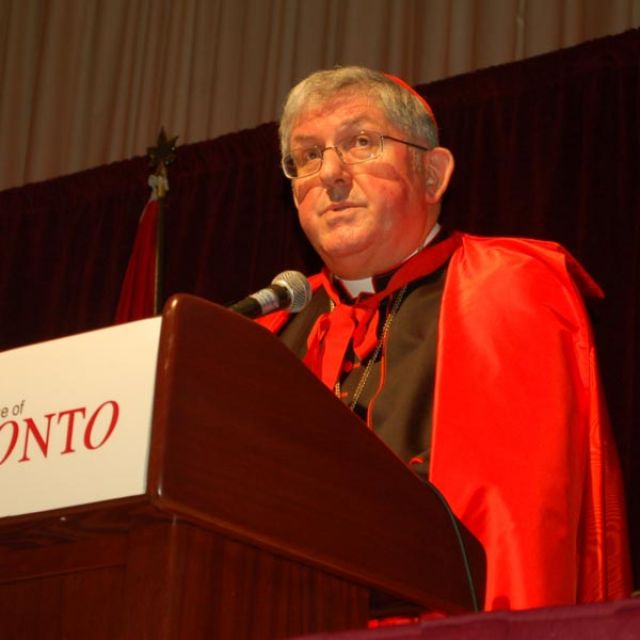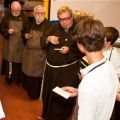[Updated at 12/10/12, 10:30 a.m.]
In a rebuke to comments made by Education Minister Lauren Broten, Cardinal Thomas Collins told a packed audience that the identity of Catholic schools must be respected and the mission of Catholic schools includes engaging in pro-life activities.
Collins made his comments to 1,700 people at the annual Cardinal's Dinner on Thursday night a day after Broten suggested that under the province's new anti-bullying legislation Catholic schools should not be teaching that abortion is wrong because "Bill-13 is about tackling misogyny."
"Taking away a woman's right to choose could arguably be considered one of the most misogynistic actions that one could take," she said at a press conference. "I don't think there is a conflict between choosing Catholic education for your children and supporting a woman's right to choose."
Collins did not specifically mention Broten, and neither she nor Premier Dalton McGuinty attended the dinner at Toronto's Metro Convention Centre. The Ontario government was represented by Minister of Citizenship and Immigration Charles Sousa. He heard the cardinal defend the rights of Catholic education in no uncertain terms.
Collins said the Catholic identity of Catholic schools is "recognized and protected" by section 93 of the constitution and by section 1 of the Education Act.
"Both the constitution and the Education Act make it clear that the Catholic identity of the school must be respected," he said.
Then, referring to Bill-13, the government's anti-bullying legislation, he said:
"This is true when it comes to the establishment of anti-bullying groups designed to make the school a better place for all, and in Catholic schools that means following the method outlined in the document Respecting Difference, of the Ontario Catholic School Trustees Association. It is our mission to speak up for all those who suffer, and especially those who are voiceless, for those who are forgotten.
"It is also true when it comes to protecting the freedom of all in the school community to engage in pro-life activities in order to foster a culture of life in which the most vulnerable and voiceless among us are protected and honoured throughout their whole life on earth from the moment of conception to natural death.
"Defending the voiceless is our mission."
Collins reminded the audience that Catholic education has been an integral component of Ontario schooling since before Confederation. He said the province was blessed to have a religious and non-religious education system that "work together in co-operation to make education a treasure for which all Ontarians may truly be thankful."
"There is more beauty in the variety of a garden than in the uniform, undifferentiated, monotony of the dull flat surface of a parking lot," he said.
"The complementary variety in our educational system is an advantage for all, producing not only a healthy competition from which all benefit, but also a fruitful collaboration, and the richness of different approaches to the key issues of life.
"That diversity reflects the reality of the differences that exist in our province. The system works."
Broten, who doubles as the minister responsible for women's issues, made her comments on Oct. 10 after Campaign Life Coalition (CLC) held a press conference at Queen's Park to promote weekend rallies that will demand the province stop funding abortion through Ontario health insurance. The CLC press conference was sponsored by three Conservative MPPs.
In posing a question to Broten, a reporter said "the Catholic school system in this province is teaching the kind of intolerant thought that we saw coming out of that (CLC) press conference. They let kids out of school to go to anti-abortion rallies. Is that appropriate?" When Broten dodges that question, a reporter again asked: "Should schools be encouraging kids to go to anti-abortion rallies?"
"In Ontario, we support Catholic education, support the teaching of love and tolerance in our schools and at the same time we support the right to chose." she replied. "I am one that supports Catholic education and has been adamantly inn support of women's right to chose for many years and I do not see a conflict in those."
Mission priest gets his view of justice from pre-Vatican II Nova Scotia
By Michael Swan, The Catholic RegisterTORONTO - A lot of people don't know that God is Brazilian, but Scarboro Mission priest Fr. Ron Macdonell has had 26 years of working with indigenous people in the Amazon River basin to learn just how Brazilian God can be.
"Deus é Brasileiro," is a popular saying among Brazilians.
"To me it says that the Brazilians are very close to God and God is their creator. God made them," said Macdonell.
God made Brazilians even if it's hard to say what exactly a Brazilian is. Brazilian identity is a constant puzzle that goes much deeper than soccer and samba, bikinis and coffee.
For a missionary, the question of identity is worked out in faith.
"You can be Catholic in Brazil. You can be Chinese Catholic. You can be Nigerian Catholic. You have to look at what's cultural and what isn't," said Macdonell. "Looking at Brazil, Brazil is a mishmash of all the world's cultures."
Macdonell has lived most of the last 26 years among Macuxi native people in the rainforests of the Amazon, straddling the equator.
Macdonell doesn't think of himself as a missionary to Brazil. Rather, he is a missionary with the Macuxi people. He was living with the Macuxi in the northern Brazilian state of Roraima until the Scarboro Missions called him back this year to serve on its leadership council. Though now based in Toronto, Macdonell will return to his Macuxi community a couple of times a year for extended visits.
The 54-year-old identifies himself as a child of Vatican II, but traces his vocation back to pre-Vatican Council roots in Antigonish, N.S.
"This vision of justice was one feature of the pre-Vatican Church in Nova Scotia — the Antigonish Movement, the co-op credit union movement, Moses Coady and Fr. Jimmy Tomkins. I heard about all that from my parents," he said. "Then the second experience that was formative for me was the Antigonish diocesan priests who were working in Honduras as part of the Church's call to aid Latin America. I would hear about them."
A talent for languages also en- couraged Macdonell's vocation. He isn't just fluent in English and Portuguese. He has of course learned the indigenous languages of Roraima — Macuxi and Yanumami. Japanese was fun to learn. And when he did his PhD in linguistics it just seemed more intreresting to do it in French at Université de Laval in Quebec.
In the context of the Brazilian Church, Macdonell has a very clear sense of the Second Vatican Council as a living and breathing force.
"In Brazil we have a very strong component of the Church that works along social lines and the social Gospel," he said. "Any study of the catechism is not just a call to personal conversion and learning about the Catholic faith. It is also a call to missionary involvement in the local community."
Which means he's not the only missionary when he meets with his Macuxi parishioners. They're all missionaries. The priest's job is to give them the tools and the confidence to be missionaries in their own communities, even their own families.
"So the importance of leadership training is vital. And this is with people who do not have a lot of schooling — perhaps four years of school," he said. "A lot of our work — the sisters and the other priests I work with — is to form teams that will give spiritual training in how to read and interpret the Bible."
Macdonell sees the 19th-century missionaries as driven by sheer numbers of baptisms and the establishment of new parishes. Around the Second Vatican Council the emphasis shifted to institutions — clinics, hospitals, schools, labour centres.
But today's missionaries are focussed on formation so that people can really take ownership of their faith.
"It's sort of an invisible, unmeasurable mission," he said.
There will be no neat statistics that show how confident and wise parish leaders have become. But in regions where there are few priests spread out over huge territory with many inaccessible communities, where Mass is celebrated as little as two or three times per year, lay leadership is essential.
There's more to leading an indigenous Church in Brazil than liturgies and Bible study. People expect the Church to be close to them in their lives.
"We're working with people in poverty, so we're trying to analyse what are the sources of this poverty," said Macdonell.
Whether the issue is local drinking water or rampant alcoholism tearing apart families, groups Macdonell works with expect their religion to help them live a better life. Meetings that start with prayer quickly move on to deal with health, employment and social issues.
Brazil's national conference of Catholic bishops encourages and supports the connections between societal challenges and religion with annual fraternity campaigns during Lent and some 30 pastoral commissions that work on land rights, homelessness, workers' rights, women, ecology and more.
"There's already a structure that has been created within the Brazilian Church that calls people to this engagement, so that their personal faith is lived out in some way," Macdonell said.
As he settles back into life in Canada for a while, Macdonell is aware that at 54 he's one of the younger priests in the Scarboro Missions. He also knows the hope Scarboro Missions once placed in lay missionaries who make three-year commitments has been hard to achieve, with few people able to abandon jobs, families and mortgages.
But he doesn't believe we're living through a twilight for missionary vocations.
"The Church will always produce missionaries and we look to where they are to find them," he said.
"We see people coming to Canada from Asia, from Latin America, from Africa to be missionaries here among us. Our Church is more and more universal. That's where the catholicity comes in. It's a common language."
ROM leads tour of Toronto’s ‘Sacred Stones & Steeples’
By Vanessa Santilli-Raimondo, The Catholic Register(UPDATED 17/10/2012)
TORONTO - It’s not common knowledge the Catholic Church in Toronto originally owned a plot of land at the northeast corner of George and Adelaide Streets. At that time in 1806, Toronto, then called York, had a Catholic population of about 37 people. Nor do most people know the chapel built on this spot was taken over by soldiers during the War of 1812. The land was eventually sold in order to buy the property where St. Paul’s Basilica stands today.
“The only research is in the deeds to the land which was bought by a priest and it was recorded there to be left entrusted to the Roman Catholic Church,” said Paul Vaculik, a ROMwalks volunteer tour guide.
On Oct. 7, more than 60 people gathered to take part in the Sacred Stones & Steeples ROMwalks guided tour, led by volunteers of the Royal Ontario Museum. The two-hour walk covered landmark religious buildings in Toronto at the tine of the War of 1812, whose bicentennial takes place this year, as well as general historical factoids as time marched onwards.
Along with the origins of St. Michael’s Cathedral, the tour also stopped at St. James Cathedral, Metropolitan United Church, Mackenzie House, St. George’s Greek Orthodox Church and the First Evangelical Lutheran Church of Toronto.
St. Michael’s Cathedral, the oldest church on the tour, was built to accommodate the Catholic population which was growing along with the overall population of Toronto, said Vaculik. St. Paul’s, the first Catholic church in Toronto, was originally fairly small, unlike the basilica Torontonians know today.
“The population really grew because of the famine in Ireland,” he said. “The population of Toronto was 20,000 and, within five months, 38,000 Irish came over.”
Unlike the Anglicans, the Catholic Church’s main base wasn’t the affluent. It was the labourers.
“When they started building around 1847, it was like a barn-raising,” said Vaculik. “A lot of the labourers contributed their labour to building the church so they excavated the land and they started to build the church.”
The base material was ballast material from ships, he added. Bishop Michael Power received a lot of flak for choosing St. Michael’s location, Vaculik said. “It was at the northern end of Toronto and it was starting to get into the boonies, but now it’s well in the heart of Toronto.”
Vaculik also pointed out the often overlooked fact that the galero of Cardinal James McGuigan is hanging above the altar at St. Michael’s Cathedral.
“The tradition was that when the cardinal’s received their hat when they were made cardinals, when they died they would hang their hat up by the ceiling (until) it rotted and fell down.”
This practice has been discontinued, and so, the galero of McGuigan will be the last to hang in the cathedral, he said.
Amidst a backdrop of organ practice, the group was led into the Anglican St. James Cathedral, where a white bust of Bishop John Strachan greeted visitors.
A major influence in Toronto, Strachan played a role in the 1813 surrender of York, negotiating directly with the Americans despite having no official diplomatic authority. In the area of education, Strachan was responsible for establishing King’s College at the University of Toronto.
Unbeknownst to the average churchgoer, the Gothic architecture of the cathedral displays windows in groupings of three to represent the Holy Trinity, said Vaculik.
At Metropolitan United Church, another prominent name in post-secondary education in Toronto is mentioned: Methodist minister Egerton Ryerson.
“Ryerson laid down the framework for the educational system as we know it today,” said Vaculik, including the now standard notion that teachers must complete training colleges.
For more on ROMwalks tours, see www.rom.on.ca/programs.
Catechism, at 20, maintains importance as a resource for Catholics
By Vanessa Santilli-Raimondo, The Catholic RegisterThe Catechism of the Catholic Church is the best comprehensive presentation of the Catholic faith in hundreds of years, said Vancouver Archbishop Michael Miller.
"It's the distillation of the teaching of the Second Vatican Council," said Miller.
The 20th anniversary of the promulgation of the Catechism of the Catholic Church runs parallel to the Year of Faith, which kicked off Oct. 11.
Today, the catechism is used in various settings, including RCIA programs, upper- level high school or college courses, study groups and as a personal reference tool, said Miller.
"And references are constantly made to it in books that you read on homiletics and preaching."
It's an important resource because it brings together the core teachings of the Catholic Church under three categories: the Church's doctrinal positions, Christian practices and worship, said Michael Attridge, a theology professor at Toronto's University of St. Michael's College.
But if people believe the only thing necessary to live a good, full Catholic life is to read the catechism, that is a downside, said Attridge.
"People need to study the Bible, they need to involve themselves in parish organizations, organizations that promote social justice, they need to educate themselves by going to theological school and to ask questions that relate to faith and Christian living."
Since its creation, the publications service of the Canadian Conference of Catholic Bishops (CCCB) has sold 222,787 copies of the catechism in English and French, said René Laprise, director of media relations for the CCCB. In addition, 45,673 copies of the Compendium of the Catechism of the Catholic Church have been sold through the CCCB.
"A number of copies have been sold through Canadian bookstores and direct sales from publishers in the United States and France, although we have no way of determining how many," said Laprise.
Miller added that in the archdiocese of Vancouver, there's currently a big push on YOUCAT: The Youth Catechism of the Catholic Church.
"We've distributed more than 10,000 copies of YOUCAT to parishes because it's in some ways far more accessible and user-friendly for the level of knowledge of religion that most people have."
Had it not been for the anniversary of the catechism, Miller doesn't think the arch-diocese would have come up with such an initiative. And while the catechism is the standard, he said he believes YOUCAT is more in tune to how people today learn and read.
"As much as we might lament the loss — as I do — of plunging through big books, most people today read in small bits and they're used to more pictorial representations... It's just the way things are. I think it's far more effective."
Manitoba releases Canada’s first spiritual care plan
By James Buchok, Canadian Catholic NewsWINNIPEG - Manitoba’s department of Healthy Living, Seniors and Consumer Affairs has released what it says is Canada’s first spiritual health care strategic plan.
Minister Jim Rondeau said the plan, entitled Health and the Human Spirit, “will promote opportunities for Manitobans to experience spiritual health through better awareness, understanding and healing.”
The four-year strategy was developed in sessions involving a range of community and professional stakeholders, including spiritual care providers, volunteers, counsellors, physicians, psychiatrists, policy analysts and individuals who have experienced spiritual care in a health care context. Rondeau said research has shown that higher levels of spiritual well-being, along with a sense of inner meaning and inner peace, are associated with better health outcomes, lower levels of depression and anxiety and a better quality of life.
Fr. Vince Herner, chair of the Manitoba Multifaith Council and director of spiritual care at the Misericordia Health Centre, said Manitoba “has taken an important step forward with the release of this plan. It sets out a vision and goals for Manitoba and recognizes the increasing awareness that spirituality is an important part of human wellness.”
The plan builds on the province’s previous strategies for spiritual health care, including a province-wide spiritual health care volunteer education course called the Spirit of Caring, core competencies for spiritual health care practitioners and the incorporation of traditional aboriginal healing spaces at a number of health facilities.
The new document states that there is a growing awareness that spirituality, or the way a person searches for and finds meaning, “is part of human wellness and spiritual health care must become part of health care theory and practice.”
It quotes from English authors Mark Cobb and Vanessa Robshaw’s 1998 book, The Spiritual Challenge of Health Care, which concludes, “there is what many people recognize as a spiritual quality to life, which, in suffering, confronts people with questions and possibilities that reach beyond the immediate dilemmas of physical insult.” Also in 1998, the World Health Organization endorsed a proposal to include the word “spiritual” in its description of overall health.
Health and the Human Spirit states that the connections between spiritual beliefs, practices and mental and physical health “are a growing area of research that is finding its way into practice. The discipline of spiritual health care brings together our thinking, beliefs, behaviour and culture to address the many ways human beings seek to be well in body, mind, relationships and soul.”
The authors of Health and the Human Spirit conclude that the four-year strategic plan “enables new understanding, relationships, connections and directions for health care providers to offer quality care based on leading practice.”
A copy of the spiritual healthcare strategic plan is available at the Province of Manitoba’s web site under Healthy Living.
St. Michael's faculty reach contract deal
By Michael Swan, The Catholic RegisterTheology professors and librarians at the University of St. Michael's College at the University of Toronto have a new deal.
After a 10-day break in negotiations, unionized faculty and St. Michael's administration finalized their first-ever labour contract in early October.
"What we ended up with is something that reflects the uniqueness of the University of St. Michael's College and upholds the best of what we have in our sector across Canada," said theology professor Michael Attridge, who participated in the 18 months of negotiations on behalf of 18 members of the faculty association.
The sticking point in negotiations had been how and when the college would declare programs and courses redundant. The union feared a system which would allow administration to unilaterally cancel programs and lay off faculty without regard to tenure. The administration proposal was a threat to academic freedom, Attridge said.
"Tenure and permanent status guarantees the integrity of academic freedom," he said.
Under the new agreement, faculty members will sit on committees that decide when budget realities at St. Michael's require that programs be trimmed. They will also sit on separate committees that decide which programs should be cancelled. Faculty will not have a majority vote on either committee.
"What we've put back in place is the collegiality of the governance of the institution," Attridge said. "Members of our association will participate in that decision making."
Theological faculty association members primarily deliver courses to graduate theology students of the Toronto School of Theology, a consortium of three Catholic and four Protestant theological schools at the University of Toronto. The St. Michael's faculty also teach a small number of undergraduate classes.
A statement e-mailed to The Catholic Register from the St. Michael's College administration called the agreement "a solid working document within which the parties can continue to conduct their collegial relationship."
The agreement covers three years from July 1, 2011 to June 30, 2014.
D&P raises $1.8 million for African relief
By Catholic Register StaffMillions of Africans have food today thanks to $1.8 million Canadian Catholics have given to their development agency.
The federal government will kick in about $1.3 million in matching funds to top up five months of fundraising by the Canadian Catholic Organization for Development and Peace.
As drought struck the six-country region in May, Development and Peace saw famine on the horizon and began raising money. By August Ottawa stepped in to announce a matching funds program. A final tally of how much of Development and Peace's Sahel region fundraising is eligible for matching funds is pending, but so far the organization has identified approximately $1.3 million that Ottawa should match.
The total Development and Peace commitment in the region comes to almost $8 million, including a $5-million food distribution program the Canadian bishops' development agency is working on with Canadian Foodgrains Bank in three Sahel countries.
In Mali, Niger, Burkina Faso, Mauritania, Chad and Senegal Development and Peace is working with longstanding partner agencies and the Caritas Internationalis network on seed and food distribution, cash-for-work programs, subsidized food sales and nutrition clinics.
The federal government matching program ended Sept. 30.
Retirement beckons York Region director of education LaRosa
By Evan Boudreau, The Catholic RegisterYork Catholic District School Board director of education Susan LaRosa has announced that she will retire when her contract expires on Dec. 31.
“Well you know I’ve been in the education business for 45 years and I’ve enjoyed every moment of it for sure,” said LaRosa. “I have a great prayer life and the Lord told me it’s time to use my skills in a different way and after 15 years I decided to retire.”
During her career as an educator LaRosa moved up through the ranks, from teacher to principal, superintendent and most recently director of education.
She became director of education during a difficult time for the York board. Changes introduced when the Mike Harris Tories were in power brought challenges to school boards across the province in the late 1990s, and with it labour unrest.
“As a director there are always challenges that come our way,” said LaRosa. “The most satisfying part is that we’ve always been able to stand side-by-side in all the challenges and come up with a win-win solution that kept people first. That to me is the most satisfying part of my experience as a director.”
Over the years she and her colleagues worked towards “re-culturing the board” by building stronger relationships between teachers, parents and other education stakeholders.
Her attitude towards building personal relationships is what led Elizabeth Crowe, chairperson of the board, to say that LaRosa redefined the three Rs to relationships, relationships and relationships.
“Her first mandate was to do some mending of fences with our employee group that resulted in some stability in the system,” said Crowe. “That success is founded on a respect for the professionalism of all employees, a welcoming atmosphere in our schools, recog- nition of the vital role of parents, priests and the community and a commitment to fostering all levels of student leadership.”
Although LaRosa will be missed by all trustees Crowe said the board is excited to work with a new director of education.
“She will be missed but at the same time we are excited and looking forward to working with the new director of education,” said Crowe. “Over the years we’ve developed a friendship at a certain level; I wish her all the best and I know that all the other trustees feel the same way. She has always been able to see the big picture and she has always been open to working with trustees and understanding the political atmosphere that we work in.
“As chair she has made my life easy because she has been able to see that part of the educational system and she respects that.”
Since becoming the director of education LaRosa has been recognized for her dedicated work many times including with an Administrator of the Year Award from Niagara University’s College of Education, the President’s Award from The Council of Exceptional Children of York Region and in May 2009 she received The Learning Partnership’s Champion of Education Award.
Now in the homestretch of her career, LaRosa said she plans to remain an active member of the community.
“I have way too much energy to fully retire so I would like to perhaps pick and choose where I can use my talents and have not such a hectic schedule,” she said.
Her successor has yet to be named.
Community kicks in to redo Goderich school yard
By Evan Boudreau, The Catholic RegisterA new outdoor learning pavilion unveiled this September at Goderich, Ont.’s St. Mary’s Catholic Elementary School symbolizes the community’s commitment to the town’s boast that it is Canada’s prettiest town.
“That pavilion to me ... symbolizes what a community can do when it pulls together,” said Vince Trocchi, St. Mary’s principal. “There is community pride and this school is a big part of the community and that’s why it is important to them. It looks just beautiful out in our yard.”
For the past three years the local parent council had been working towards upgrading the school’s outdated playground. When opportunity to partner with the school board to build an outdoor learning pavilion came up, it seemed like a natural fit.
With the board offering to match funds raised for a pavilion, which costs between $20,000 and $25,000, the St. Mary’s Parent Council turned to members of the picturesque community on the shores of Lake Huron to meet its $10,000 fundraising goal. Most of the money was gathered during the last school year.
“The board matched our fundraising efforts and what you see is the fruits of our labour in our yard and family and students just absolutely love it,” said Trocchi.
St. Mary’s is one of 12 schools across the Huron-Perth Catholic District School Board to partner with the board to build the pavilions.
“We did it on a phase-in process because obviously the dollars needed to be allocated on a yearly basis,” said Martha Dutrizac, director of education of the Huron-Perth board. “We worked with our schools to put a plan in place that would give them the time necessary to collect their dollars.”
Funding from the board’s end came from the capital projects’ budget, said Dutrizac. Once the school’s collected cash, bids to begin construction were sought from local contractors.
The pavilions will be used not only during instructional time but also after hours by the community, provided the intended usage doesn’t conflict with Catholic values. In Goderich not only did the townspeople get behind the project, but the municipality itself offered its support.
“Our custodian made some contacts with people and they hamade some arrangement that (we could use tables that would be stored for the winter) during the school year when tables wouldn’t be in high demand,” said Trocchi. “It’s a win-win for everyone. They don’t need to store it somewhere (because) we’re actually using it and we win because there are really nice tables in our pavilion.”
Trocchi believes if he were to have called on the community again to furnish the pavilion there is no question it would have responded with open wallets.
“We are very pleased that we have this great partnership with our municipality and we are very grateful that they were able to do this for us,” he said. “It was one of those things that, yeah, we probably could have raised the money for it but we have a wonderful community that is willing to help us save those dollars for other items.
“I’m really proud of the way this community has pulled together to help make these kinds of things happen.”
COLF exhorts families to engage in new evangelization
By Deborah Gyapong, Canadian Catholic NewsOTTAWA - To mark the Synod on New Evangelization taking place in Rome Oct. 7-28 and the beginning of the Year of Faith, the Catholic Organization for Life and Family (COLF) has released a leaflet urging families to spread the Good News.
In “The Gospel of Everyday Life: an Adventure Worth Sharing,” COLF explains the role of the family as a domestic Church as well as that of lay faithful in evangelizing in light of the teachings of the Second Vatican Council and Scripture.
For decades, Catholic Church leaders have been calling for the new evangelization — “new in its ardour, new in its methods and means of expression” because “too many of the baptized live as if God does not exist,” COLF says.
“Their way of life, their opinions, their choices are aligned with an atheistic or relativistic vision of life.”
Not only baptized Catholics need to hear “Christ spoken of seriously” but so do those “with whom we rub shoulders at work, school or university, in the shopping mall, the subway or bus, in our leisure and volunteer activities."
Woven throughout with quotes from Pope John Paul II and Pope Benedict XVI, the leaflet urges people to collaborate with Christ in introducing Him to family members, friends and others.
The leaflet suggests a gentle, humble approach rather than aggressive proselytizing or imposing one’s faith on others. COLF invites Catholics to deepen their personal relationship with Jesus Christ through prayer, study of the faith and more frequent participation in the Eucharist and the sacrament of Reconciliation.
COLF focuses on Jesus the Son of God, laying out the Gospel message in a way that makes it easy to share with others. Invite Catholics who have fallen away to come back to Church, and invite others to “come and see” and be prepared for when a friend might ask, “What must I do?” to know Christ.
Evangelization is not just for priests, bishops and those in religious life, COLF insists, but is part of the call of all the baptized. It’s also the call of families as domestic churches, the leaflet says.
“God is counting on us, as parents, to make our children apostles of the new evangelization,” it says. “Whoever speaks of evangelization is obviously speaking about relationships, because we must enter into relationship with another person to be able to share with him or her the secret of our happiness.
“By nature, we are relational beings, because we are created in the image of God — Father, Son and Holy Spirit, eternally in relationship,” COLF says.
Evangelization, especially in the family, is not composed of “great speeches or theoretical lessons but through everyday love, simplicity and daily witness.”
The leaflet has a section entitled “Riddle time!” that has a question and answer format that is easy to share with children. It also includes a page with discussion questions for adults that would be appropriate for small group discussion.
The document is downloadable from Colf's web site at www.colf.ca. A workshop guide is also available.
Franciscans court 'Lady Poverty' at St. Francis Table
By Michael Swan, The Catholic RegisterTORONTO - On the Feast of St. Francis of Assisi Toronto's Capuchin friars came courting "Lady Poverty" in Parkdale, where they've been courting her the past 25 years.
"Lady Poverty" was how St. Francis, in the courtly language of the 13th century, conceived of life with and among the poor. Today's Franciscan Capuchins serve "Lady Poverty" by dishing up ravioli, salad, chili con carne and bread with coffee and dessert for $2 at St. Francis Table in the heart of Parkdale, in the city's west end.
There were seven local Capuchins at St. Francis Table serving lunch on Oct. 4. They were there to share a Franciscan feast with the poor and to honour the 25th anniversary of the Franciscan restaurant.
Since it opened Christmas 1987 there's never been much doubt about the Franciscan and Christian foundations of St. Francis' Table, said provincial superior Fr. David Connolly. But "the neighbourhood is changing," he said.
It had always been the Franciscans' intention to hand St. Francis' Table off to lay people with the drive and the ability to sustain the work. That would free up the religious order to launch new ventures.
Watching new condo towers encroach and local businesses replaced with chi-chi restaurants, Connolly thinks that day may be coming soon.
"We would certainly consider moving where the poor move... when the time comes," he said.
In the meantime, St. Francis' Table is having no trouble filling the dining room with people who need a good meal, good company and some encouragement.
Robert Tait has been coming to St. Francis Table the last six months and describes it as "a good place to be."
"It grounds me. It helps me to stay strong in my faith," he said.
St. Francis' Table also has an important ministry to thousands of young volunteers, said Grade 10 religion teacher Mark Henry. On the Feast of St. Francis, Henry brought nine of his Our Lady of the Lake students from Keswick, Ont., to get a more realistic picture of poverty.
"It opens their eyes," he said.
Noting a couple with a child in a stroller who had come for lunch, Henry said he hoped his students understood that the poor are not so different from their own middle-class families.
"It's not the cliché thing. None of us are that far away from poverty," he said.











